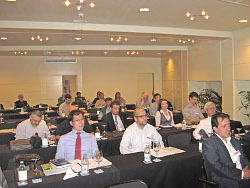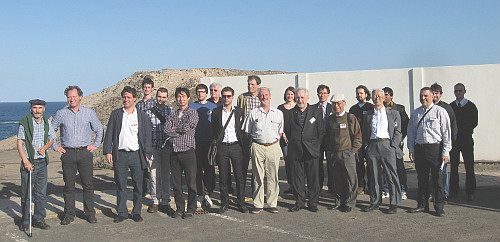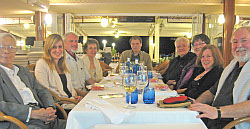3rd International Conference on Physical Coastal Processes, Management and Engineering
9 - 11 April 2013
Gran Canaria, Spain
Overview

The 3rd international conference on Physical Coastal Processes, Management and Engineering has recently taken place in Las Palmas, Canary Islands, organised by Wessex Institute of Technology and the University of Las Palmas de Gran Canaria. The meeting was sponsored by WIT Transactions on Ecology and the Environment, and the International Journal of Sustainable Development and Planning.
The meeting was the latest in a series of scientific conferences, originating in Malta (2009), followed by Naples in 2011.
Coastal zones play a very important role as they account for nearly a quarter of all oceanic biological production, which in turn supplies approximately 80% of the world’s fish. Furthermore, more than 60% of the human population lives in the coastal zone, and around 70% of the big cities are place in this narrow area. As a consequence of this high accumulation of people and human activities, coastal regions present a complex dynamic web of natural and human related processes, giving rise to numerous environmental problems which must be studied to lead managers and engineers to take decisions and act accordingly.
The most popular demands on coastal areas by residential, industrial, recreational and tourism activities have increased the need for researching shore and near-shore dynamics, with special emphasis on topics related to coastal and beach protection, artificial beaches, efficient ports and harbours, as well as the optimal drainage and construction of outfalls for the proper dispersal of waste water to the sea.

Most of the coastlines are subjected to the direct impact of wind waves, swell and storms. As a result, wind waves and wave driven currents are the dominant mechanisms controlling littoral sand transport and determining the near shore morphology. In addition, many other physical phenomena, such as tides and associated currents, long waves and storm surges, amongst others, can play a significant role in the dynamic behaviour of the coastal zone.
The physical aspects of coastal processes have been of concern for a long time, but recent advances in a number of areas, including satellite remote sensing, have given rise to significant progress in this field. In particular, the use of satellite and imaging systems has significantly enhanced the monitoring and understanding of coastal processes. It has become also clear that the ocean side of the coastal zone is very sensitive and particularly vulnerable to any kind of man-made action or natural extreme events. Consequently, the problem of environmental protection and conservation takes special relevance in the zone, and any decision concerning its viability must be preceded by a forecast of its consequences. Their adequate protection requires a clear understanding and careful analysis of the fundamental dynamic processes occurring in such areas.
A greater knowledge of sediment transport mechanisms at beaches may avoid some common mistakes of the past, consisting of uncontrolled development of groyne fields and seawalls, dam constructions on rivers that reduce sand supply to the coast, hydrocarbon and groundwater extraction, including local ground subsidence and associated flooding and erosion of coastal areas.

In the light of the above, there is a need for specialised forums, such as the Coastal Processes conference, to facilitate international exchange of state-of-the-art research and practice, as well as promoting international collaboration on coastal research exploration and coastal hazard mitigation practice.
The conference discussed recent development in a wide variety of topics, grouped under the following major headings:
- Wave modelling
- Coastal processes
- Coastal zone management
- Sediment transport and erosion
The meeting was enhanced by a series of reports and international presentations.
Keynote Address
The keynote address was given by Prof Pau Liu, Eminent Scientist from Great Lakes Environmental Research Laboratories of NOAA in Michigan, USA. The title of his presentation was ‘Unrelenting challenges for freaque wave studies in ocean coastal regions: defining the phenomena'. The presentation pointed out the relative unknown and unexplained aspects of freaque waves and the challenges that they represent. There have been significant achievements in freaque wave research in connection with nonlinear physics. Dr Liu explained what is known or still to be explained, and the challenges that are still to be faced. The conclusion is that more spatial ocean wave measurements are needed. Nonlinear physics studies have greatly contributed to the development, achievements and popularization of modern freaque wave studies. However, there is still much to be determined.
Invited Contributions
Other invited presentations were as follows:
- “Spatial variability of wave energy resources around the Canary Islands”
by G Rodriguez, University of Las Palmas de Gran Canaria, Spain. - “Smoothed particle hydrodynamics applied in fluid structure interactions”
by C Crespo, University of Vigo, Spain. - “Evaluation of wave energy transmission through a floating breakwater using the SPH method”
by A Rueda, University of Las Palmas de Gran Canaria, Spain. - “Statistical assessment of annual patterns in coastal extreme wave conditions”
by J L Vega, University of Las Palmas de Gran Canaria, Spain. - “Numerical analysis of fluid flow in a three-dimensional porous enclosure by the Boundary Element Method”
by J Kramer Stajnko, University of Maribor, Slovenia. - “Use of X-band marine radars as a remote sensing system to survey wind-generated waves”
by J C Nieto Borge, University of Alcala, Spain. - “A brief history of the sand drifts on the Jæren coast, Norway”
by O T Gudmestad, University of Stavangar, Norway.
Excursion and Conference Dinner
The conference programme offered the delegates numerous occasions to interact with each other during lunches and coffee breaks as well as during the technical visit and at the dinner and banquet.
The conference programme included a technical visit to the PLOCAN Centre where the delegates were given a presentation describing the objectives of this important project.

The Oceanic Platform of the Canary Islands (PLOCAN) will provide a multi-purpose technical scientific service infrastructure composed of a series of facilities to support research, technological development and innovation in the ocean. The aim of PLOCAN is to further excellence in marine sciences and associated technology.
The platform now under construction will be located in a zone especially suited to meteorological and oceanographic studies in the confluence of the North African upwelling and the Canary Current. This is a unique region due to its biodiversity.
Delegates were able to visit the building supporting the work being carried out to finalise the platform which is still under construction. They saw some of the numerous contributions to be undertaken by PLOCAN, including those in the field of ocean renewable energy, multiparameter large buoys, gliders to measure velocities and other important equipment.
The conference dinner took place in a well known restaurant offering genuine canarian food. There the delegates had occasion to try the famous potatoes with their special sauce, a variety of Canarian cheeses, the classical corn porridge that was the staple diet of the islanders for centuries and other local specialities. The excellent fish and meat were complemented by good wines and lively company. A few speeches and toasts contributed to strengthen the links amongst the delegates who were complimentary to German Rodriguez, the local organiser, for his choice of venue.
ISAC Meeting

The conference was very successful in terms of making new contacts and networking, creating possibilities for further collaboration and joint research projects.
Conference Proceedings
The proceedings of Coastal Procesess 2013 - Coastal Processes III, 272pp (Print ISBN: 978-1-84564-698-1 ; eISBN: 978-1-84564-699-8) are available from WIT Press. Orders can be placed on the WIT Press web site at www.witpress.com or by email:
Papers from the conference will also be hosted online at the WIT eLibrary as Volume 169 of WIT Transactions on Ecology and the Environment (ISSN: 1746-448X, Digital ISSN 1743-3541). For more details visit the WIT eLibrary at http://library.witpress.com
Associated conferences
• Water Resources Management 2013

 Wessex Institute
Wessex Institute